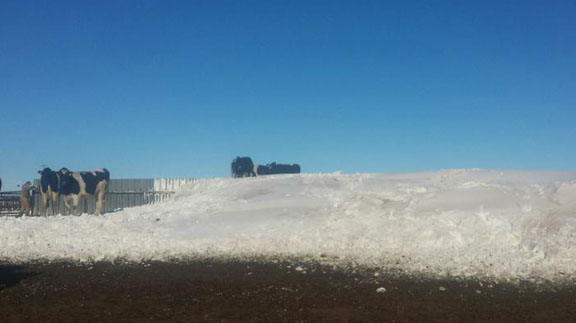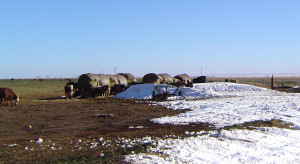Farm & Ranch
[AgriLife Today] Others offer materials for Goliath, other disaster victims

By: Paul Schattenberg
COLLEGE STATION – When winter storm Goliath tore through Texas in late December it brought more than heavy snow, ice and wind gusts of up to 80 miles per hour. It brought the death of an estimated 23,000 dairy cows and other livestock, as well as great deal of personal and financial devastation to many people.
To help those in Texas and elsewhere affected by Goliath and other disasters, Texas A&M AgriLife Extension Service has identified a number of publications by its agency and other cooperative Extension programs throughout the nation addressing some of the emotional and financial issues resulting from a disaster.
These publications, as well as other publications to prepare for and recover from disasters and emergencies, can be found at the Texas Emergency and Disaster Extension Network, or Texas EDEN, athttp://bit.ly/1OmofPI.

Texas A&M And other cooperative Extension services throughout the nation have resources to help those agricultural producers affected by Goliath. (Texas A&M AgriLife Extension Service photo by Dr. Ted McCollum)
“Natural disaster events are stressful, and those involved can experience both emotional and financial stress,” said Dr. Rick Peterson, AgriLife Extension family life specialist, College Station. “It is important to remember that in times of high stress to take steps to monitor the emotional and physical health of your family, co-workers and yourself.”
Peterson, who recently gathered information on publications providing guidance and resources for those affected by Goliath and other disasters, is a marriage and family therapist. He has seven years experience working as a crisis intervention specialist with the Kansas Agricultural Mediation Service. He has counseled farmers on a number of issues, including stress due to financial hardship, and has coordinated long-distance interventions with sheriff offices to assist despondent farmers.
Peterson said the recent blizzard and aftermath likely has increased the amount of stress and strain for many producers and their families.
“Before I became a therapist, I was involved in farming and dairy,” he said. “I remember a couple of times we had to dump milk because the bulk truck couldn’t make it to the farm to pick it up. That was pretty hard on the cash flow, but was only a fraction of the type of economic and personal stress experienced by many of those affected by Goliath and other disasters.”
Peterson said for livestock owners and workers, the grief over the loss of animal life may be compounded with fear and insecurity about their future livelihood.
“Feelings of loss, grief, anger, anxiety and depression are normal reactions to a disaster, but it’s important to understand these feelings and learn how to best deal with the stressful conditions.”
He said there are tried-and-true methods of handling the emotional aftermath of a disaster, and people affected can take positive action to manage stress and build “an emotional and financial recovery plan.” Peterson gave tips on how people can better communicate under stressful conditions, manage their stress and find help for themselves or others.
“People should communicate frequently and be clear and direct in their communications. It’s important to not only be an active listener but to heed non-verbal messages as well as those spoken. You should be positive in your communications and speak honestly and openly.
“To manage stress, you can talk to a family member or friend or, if necessary, seek professional guidance. Talk with someone about your feelings, whether it’s anger, sorrow or another emotion, even though it may be difficult. You can also seek help from a professional counselor who has experience with post-disaster stress.”
Peterson said it’s also important not to blame one’s self or feel responsible for a disastrous outcome or to be frustrated because of any inability to help one’s self or others.
“It’s vital after a disaster that people take steps to promote their own physical and emotional well-being by healthful eating, rest, exercise and relaxation.
“Try to maintain a normal family and daily routine and limit any additional demanding responsibilities for yourself or your family. It’s important not to withdraw and to maintain those relationships with friends and family. Family and friends, as well as religious institutions and clergy, can be excellent sources of support and comfort after a disaster.”
Peterson said it’s also important that friends and family try to help people they know who are in distress but seem to be unable to handle their situation.
“Become aware of mental health resources in your community,” he said. “Be alert to signs and symptoms that the person may need help and discuss your concerns with the person. Find out if he or she is willing to seek help and provide the person with referral information. Then follow up to see if the person took action and if the person or agency you referred was helpful.”
Peterson suggested specific publications from AgriLife Extension and other cooperative Extension services to help those affected by Goliath and other disasters:
— Stress in Adults After a Disaster: Warning Signs and Management, AgriLife Extension.
— Managing Stress, Anger, Anxiety and Depression on Dairy Farms, Colorado State University.
— Taking Charge: All About Stress, Iowa State University Extension and Outreach.
— Recognize and Manage the Stress of Farm Life, Ohio State University Extension.
— Stress Management After a Disaster, University of Arizona Cooperative Extension.
— Getting Through Tough Financial Times, University of Illinois Extension.
— Farm and Ranch Family Stress and Depression: A Checklist and Guide for Making Referrals, Colorado State Extension.
— Referring a Person for Help, University of Illinois at Urbana-Champaign.
He also offered the following links for finding professional assistance:
— The Therapist Locator, listings of marriage and family therapists by zip code, city and state, http://therapistlocator.net/iMIS15/therapistlocator/.
— Psychology Today, listings of psychologists, therapists and counselors by state,
https://therapists.psychologytoday.com/rms/.
— Texas Department of State Health Services, listings of local mental health centers in Texas,
https://www.dshs.state.tx.us/mhsa/lmha-list/,
— Behavioral Health Collaborative of New Mexico, listings of behavioral health providers in New Mexico, http://www.newmexico.networkofcare.org/mh/.
-30-
Find more stories, photos, videos and audio at http://today.agrilife.org
Farm & Ranch
Acorn Toxicity

By Barry Whitworth, DVM, MPH
With the prolonged drought, most pastures in Oklahoma end up in poor condition. With the lack of available forage, animals may go in search of alternative foods.
If oak trees are in the pastures, acorns may be a favorite meal for some livestock in the fall. This may result in oak poisoning.
Oak leaves, twigs, buds, and acorns may be toxic to some animals when consumed.
To read more, pick up a copy of the November edition of North Texas Farm & Ranch magazine, available digitally and in print. To subscribe by mail, call 940-872-5922.

Farm & Ranch
Silver Bluestems

By: Tony Dean
There are a handful of grasses on North Texas grazing lands ranchers need to know, not because they are highly desirable, but rather because they are not of much value. I call them “decom” plants, which is am acronym for “Don’t Ever Count On Me.” Silver bluestem is a “decom” grass.
Silver bluestem is a perennial which grows in all areas of Texas. It can survive in almost all soil types, and in full sun conditions or in semi shade. It grows up to three feet tall and is easily recognized with the presence of the white fuzzy seed head. Also, one of the identifying characteristics of Silver bluestem is a bend in the stems at each node, causing the plants to take on a rounded shape as they mature.
To read more, pick up a copy of the November edition of North Texas Farm & Ranch magazine, available digitally and in print. To subscribe by mail, call 940-872-5922.

Farm & Ranch
Meanwhile Back At The Ranch

By: Rayford Pullen
Fall is here which means winter is closing in on us and before we officially get into winter, we need to make sure our factories are either producing or will be producing in a few months.
We have been pregnancy testing our cows this fall and if they are not bred or nursing a calf, we are bidding them adios. With annual costs somewhere between $900.00 and $1,000.00 per cow, those cows not producing a live weaned calf are costing us quite a bit.
To read more, pick up a copy of the November edition of North Texas Farm & Ranch magazine, available digitally and in print. To subscribe by mail, call 940-872-5922.
-

 Country Lifestyles2 years ago
Country Lifestyles2 years agoScott & Stacey Schumacher: A Growth Mindset
-

 Country Lifestyles8 years ago
Country Lifestyles8 years agoStyle Your Profile – What your style cowboy hat says about you and new trends in 2017
-

 HOME8 years ago
HOME8 years agoGrazing North Texas – Wilman Lovegrass
-

 Equine1 year ago
Equine1 year agoThe Will to Win
-

 Country Lifestyles5 years ago
Country Lifestyles5 years agoAmber Crawford, Breakaway Roper
-

 Outdoor9 years ago
Outdoor9 years agoButtercup or Primrose?
-

 Country Lifestyles8 years ago
Country Lifestyles8 years agoJune 2016 Profile – The man behind the mic: Bob Tallman
-

 Country Lifestyles8 years ago
Country Lifestyles8 years agoDecember 2016 Profile, Rusty Riddle – The Riddle Way




